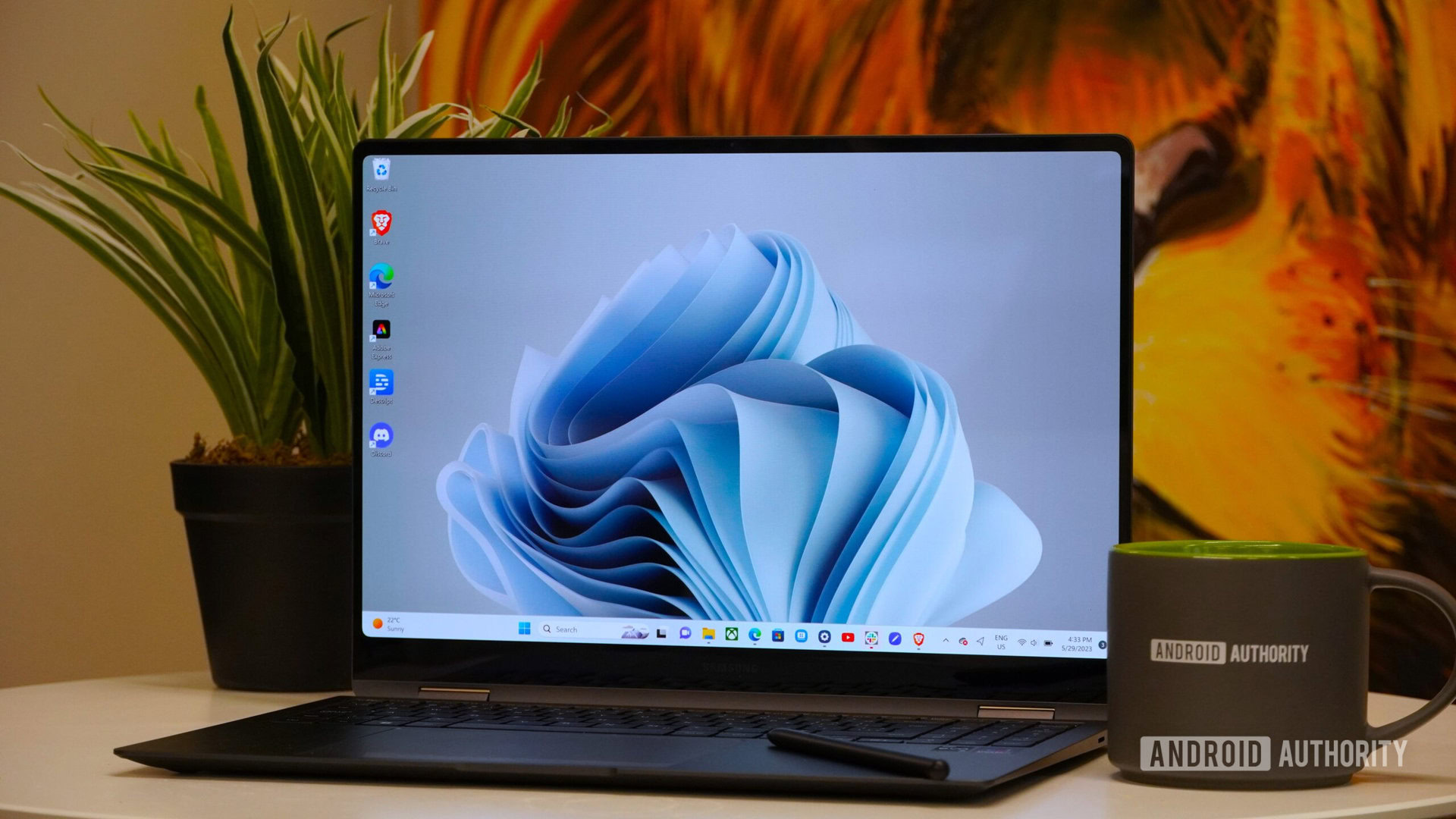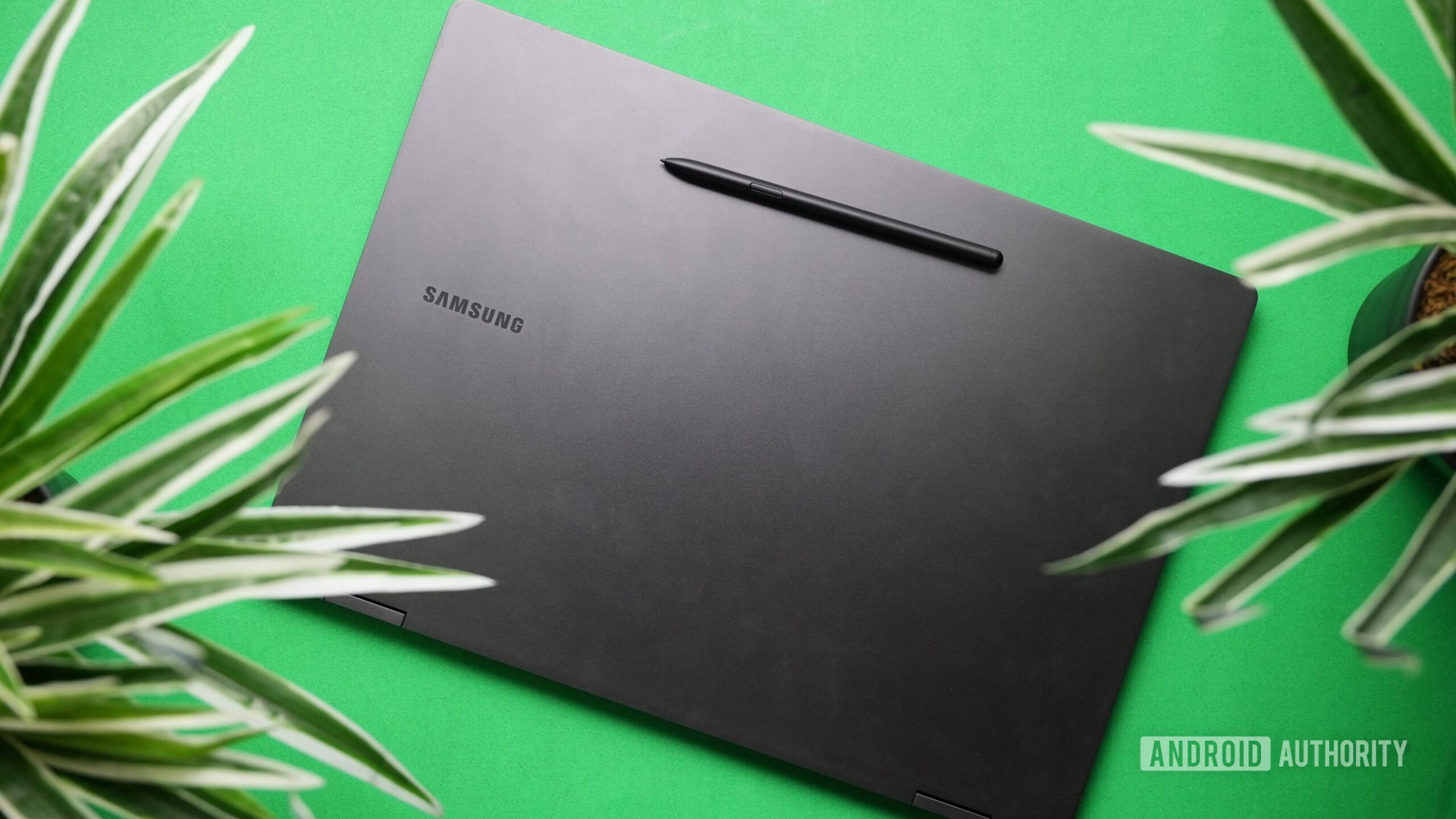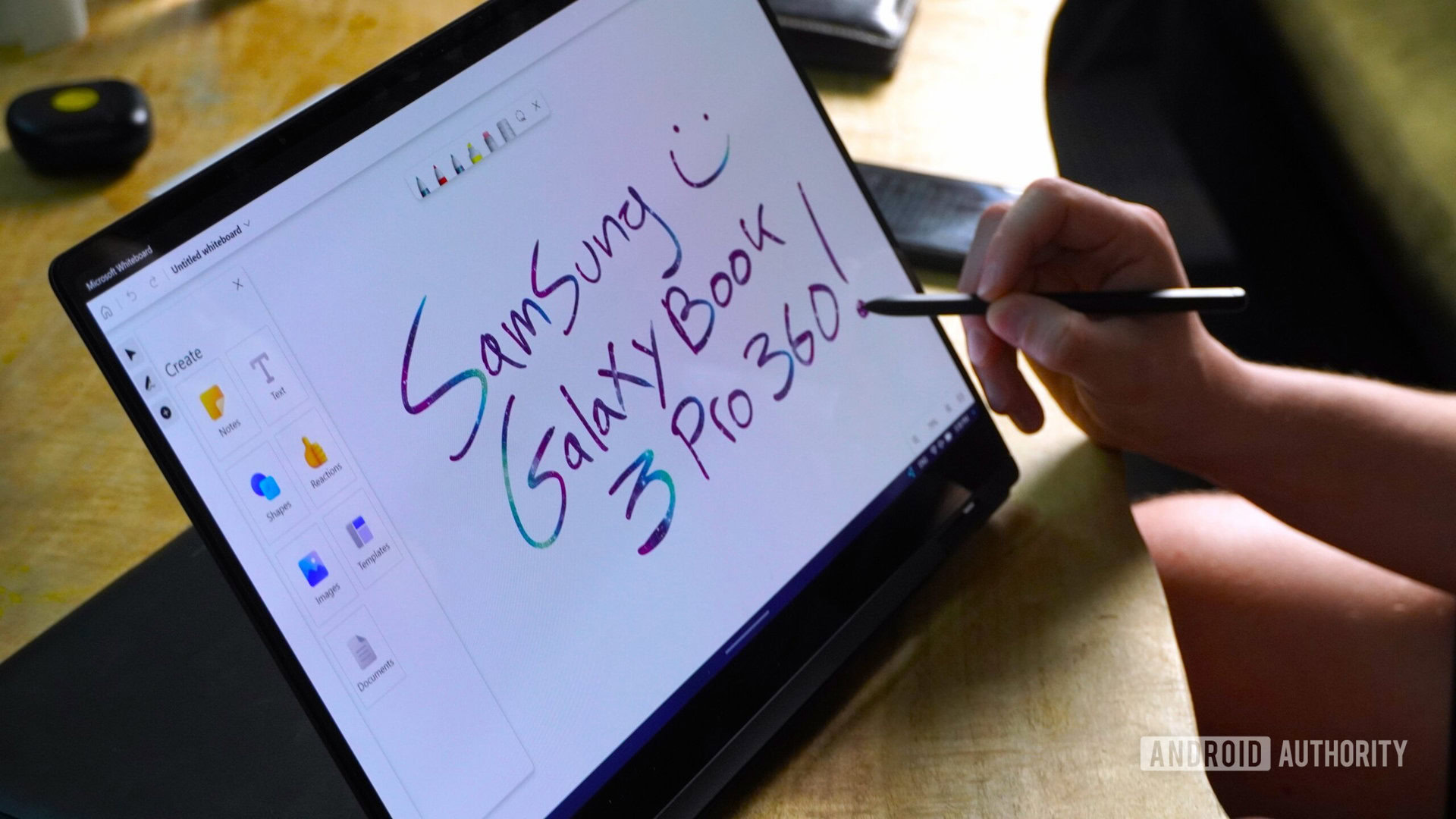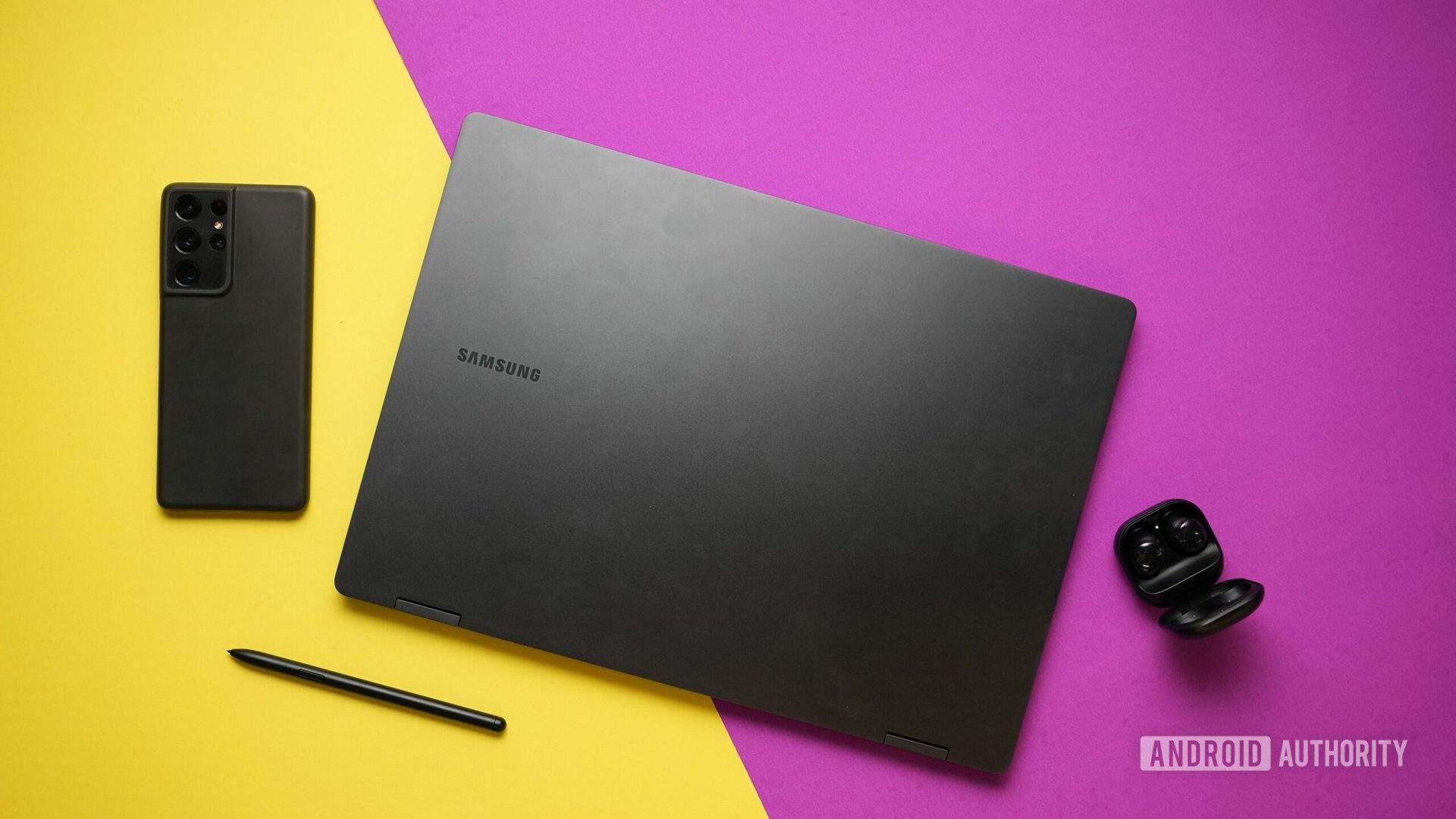Affiliate links on Android Authority may earn us a commission. Learn more.


Samsung Galaxy Book 3 Pro 360 review: A top Windows 2-in-1 for Samsung users
June 3, 2023

Samsung Galaxy Book 3 Pro 360
What we like
What we don't like

Samsung Galaxy Book 3 Pro 360
Aside from making some of the best phones on the market, Samsung is keen to take the crown in other device categories as well. Of course, Apple still dominates the tablet and laptop space as the popular consumer choice. Still, the South Korean giant is quickly catching up with sleek, lightweight computers that offer powerful performance and plenty of integrations with other products in its ecosystem. The Galaxy Book 3 Pro 360 is Samsung’s latest 2-in-1 portable productivity machine, but is it worth the price tag compared to the competition? This is Android Authority‘s Samsung Galaxy Book 3 Pro 360 review.
Samsung Galaxy Book 3 Pro 360 review: What you need to know

- Samsung Galaxy Book 3 Pro 360 16-inch (i7/16GB/512GB): $1,399.99
- Samsung Galaxy Book 3 Pro 360 16-inch (i7/16GB/1TB): $1,899.99
The Galaxy Book 3 Pro 360 is Samsung’s flagship 2-in-1 Windows laptop for 2023, which means you can use it as a traditional laptop or flip the screen over backward to use the touchscreen as a tablet mode with support for the S Pen stylus. It’s the highest-end laptop in the Galaxy Book 3 series, above the Book 3 Pro, which functions as a standard laptop, and the Book 3 360, which has the same 2-in-1 form factor but with a smaller display and without the S Pen. All of the other Galaxy Book 3 laptops come with the same CPU, memory, and storage options but sport lower-resolution screens (Full HD vs 3K).
Samsung has introduced a new 16:10 aspect ratio that is exclusive to the Galaxy Book 3 Pro version displays. It makes for a taller, squarer look than the traditional 16:9 that gives you a lot of screen real estate for reading, writing, or drawing. The 16-inch Galaxy Book 3 Pro 360 sports an Intel Core i7 processor and Intel Iris Xe Graphics card and comes with 16GB of RAM and either 512GB or 1TB SSD of onboard storage, expandable via a microSD card slot.
In the Galaxy Book 3 Pro 360 box, you get the laptop, a 65W power adapter, the Samsung S Pen, and a USB-C to USB-C cable. Samsung is selling the Galaxy Book 3 Pro 360 in most major markets like North America and Europe. The laptop is plenty future-proofed with support for Wi-Fi 6E, and there is also a 5G-enabled model, though this is only available in selected regions (not including the US at the time of writing).
The Galaxy Book 3 Pro 360 is available in Graphite and Beige and is available to buy from Samsung, Amazon, Best Buy, and other major tech retailers.
What I like about the Samsung Galaxy Book 3 Pro 360

Let’s start with the most eye-catching aspect of the Galaxy Book 3 Pro 360: the screen. Samsung has made some pretty big improvements in this department, ditching the 1080p display of the previous Galaxy Book 2 Pro 360 for a vivid 3K display with a 2,880 x 1,800 resolution (~212 PPI). The AMOLED screen also means you get true blacks with better contrast, which makes it great for streaming or gaming.
The new 16:10 aspect ratio lends itself well to the 2-in-1 form factor, giving plenty of screen real estate when used as a laptop or tablet. Reading articles felt comfortable to me in a horizontal or vertical orientation, and using the Windows 11 built-in snapping feature, it was easy to split the screen to jot down notes while watching a video or reading a document at the same time. The only thing I’m not in love with in terms of looks is the nearly one-inch thick bezel along the bottom of the screen.
The Galaxy Book 3 Pro 360's 120Hz refresh rate is something I never knew I needed on a laptop, and now I never want to go back.
My favorite feature of the display, however, is the 120Hz refresh rate. Going from a 60Hz refresh rate on the previous model, this is a pretty big leap forward, and it has sort of ruined my browsing experience for most other laptops. Everything feels so much smoother, not just for scrolling through websites and applications but especially when you are writing on the screen with the S Pen. Markings appear exactly where intended, as soon as you touch the screen, with no wiggly artifacts when drawing lines.
The Galaxy Book 3 Pro 360 is still thin as ever, standing just half an inch tall when folded and lying flat. Despite the slender style, you get a full keyboard deck with a number pad and plenty of ports, including HDMI, two Thunderbolt 4 ports, and one old-school USB-A port, as well as the microSD card reader and a headphone out/mic-in combo.
The HDMI and USB-A ports, in particular, are commendable, as they allow you to connect to external monitors or devices without the need for an adapter or USB hub. Other slim notebooks, like the MacBook Air M2, have neither, but Samsung proves it is possible to put them into a slim form factor. However, given that the laptop uses the Thunderbolt 4 ports to charge, I wish Samsung hadn’t put both on the same side. One thunderbolt port on either side would have been more versatile, allowing for easier cable reach no matter where you find yourself able to plug in with the charger.
Across the keyboard, the keys deliver stronger resistance and feel less squishy compared to the Galaxy Book 2 Pro I tested previously. There are also more brightness levels to adjust the backlight or adapt to ambient lighting conditions, which is a plus. Some people might not like the numeric keypad as it shifts the whole trackpad and keyboard off-center to the left. Still, personally, I find the Numpad handy for punching in security codes or making quick calculations.
As for the touchpad, it’s one of the biggest I’ve ever used on a laptop, measuring 7.5 inches diagonally — 39% larger than the touchpad on the Galaxy Book 2 Pro 360. It uses a diving board design that clicks at the bottom and is very responsive to swipes and gestures. Being so big, I also appreciated that the touchpad only registers presses in its lower right corner as right clicks, making it immune to any accidental right clicks if you touch or tap it on the right side.
Performance is another strength of the laptop. The 13th gen Intel Core CPU makes it fast enough to handle multiple applications for everyday work. The model I tested came with an i7-1360P and 16GB of RAM, had no trouble zipping between dozens of open tabs, and played 4K videos with no noticeable lag. The fans would kick in here and there, but they were not distractingly loud when spinning.

The Galaxy Book 3 Pro 360 scored reasonably high in Geekbench 6 multi-core test and beat out other Windows laptops that house 12th gen Intel Core i7 processors, such as the Dell XPS 13 Plus. It also rivals Apple’s lightweight MacBook Air M2 but won’t come close to the beefier MacBook Pro M2.
Now, there’s no dedicated GPU, so this isn’t intended to be a gaming laptop. For that, you’ll have to look to the more expensive Samsung Galaxy Book 3 Ultra, which has the NVIDIA RTX Graphics card. Still, I was able to play some games using Xbox Game Pass Cloud Gaming. Older titles like Portal 2 or stylized role-playing games like Persona 5 Royal ran just fine, and you can even use the touchscreen as a controller. However, I did encounter halts and stutters with more graphically intense games, such as Ghostwire: Tokyo, especially when rendering cutscenes.
As soon as you sign in with your Samsung account, the Galaxy Book 3 Pro 360 will automatically connect to all your other nearby Galaxy devices. That means you can open your Galaxy Buds case to connect them to your laptop without going through the Bluetooth settings. The Multi-Control tool also has some nifty new features, such as being able to move the cursor over to my Galaxy S21 Ultra’s screen and vice versa. It took a little getting used to, but I found it pretty handy to copy and paste files or photos between devices or use the keyboard to type a message on my phone instead of the smaller touchscreen where my thumbs are more prone to typos.
As for the S Pen, it has a nice shape and size, feels light in hand, and doesn’t need to be charged, so you don’t need to worry about it dying. Just like the Galaxy S23 Ultra, the Galaxy Book 3 Pro 360 comes with the Air Command menu, giving you some extra functionality, such as being able to make a GIF of a video on screen, annotate screenshots, or color to your heart’s content in PENUP, which is fairly fun and satisfying on the big screen canvas. Microsoft also was its own Pen menu with shortcuts to Whiteboard, the Snipping tool, and Journal, but you can customize which four apps you want to launch from here.
Audio is another area where Samsung has improved. Instead of only sporting downward firing speakers at the bottom of the chassis, as the Galaxy Book 2 Pro did, there are now a pair of woofers and tweeters tucked beneath the side edges of the frame. Highs and mids all come through clearly and at full volume, but there is a distinctive lack of base. Still, the sound is loud enough to hear, even with a lot of background noise. Of course, they’re not going to replace a proper speaker and fill a large room, but the support for Dolby Atmos makes watching YouTube or streaming Netflix a pleasure. I wasn’t drawn to listening to music on it, given the thin bass, but you can wire in with your favorite pair of headphones or connect with the best wireless earbuds to fix that.
What I don’t like about the Samsung Galaxy Book 3 Pro 360

While the sharp, AMOLED display is amazing for watching videos indoors, particularly in low light conditions, it isn’t so great at handling lots of light. The brightness levels top out at 400 nits which isn’t really enough for outdoor use under sunlight; 500 nits would have been preferable. Plus, I would have liked a stronger anti-reflection coating to handle bright light. If you are working somewhere where you can’t control the light sources, such as a room with lots of windows, it can be a bit annoying since direct light will end up washing out all those rich color contrasts.
Another thing that can be annoying is the looseness of the hinges. They are quite flexible to spin the screen around to the backside, but they are not always tight enough to keep the screen in place, especially when the laptop is resting on your lap. I’m someone who has one of those anxious tendencies to subconsciously bounce their heels, which would send the screen falling back at the slightest shake. However, the laptop does stand sturdy on a flat surface and holds well in the tent position if you want to prop it up.
When you’re not using the S Pen, there’s not really anywhere ideal to store it. The backside does have a magnet for it near the top, but it is very weak, and the pen was prone to rolling off quite frequently. I would have preferred a smaller-sized S Pen that could pop in and out of its own storage slot, like on the Galaxy S23 Ultra, as I feel like the one here could easily get lost and is easy to forget about hanging off the back by a fingernail.
The back side is a stronger magnet for fingerprints than for the S Pen.
Unfortunately, the battery life has taken a bit of a hit in this third generation of Galaxy Books. Despite packing a reasonably large 76Wh battery, it wasn’t enough to get through a full working day. For reference, my working day largely consists of web browsing, writing in WordPress, regular email and Slack usage, some image editing, and listening to YouTube Music in the background. The battery is quoted to deliver “up to 19 hours of video runtime,” but in my usage, I would average six to barely seven of use with HDR active. That is roughly two hours less than the Galaxy Book 2 Pro, and I found myself reaching for the charger more than I would have liked.
Granted, there are several battery optimization options in both the Windows and Samsung settings. On the Windows side, I enabled all seven of the energy recommendations to preserve power and found myself switching from Balanced to Best energy efficiency Power modes when running low. In the Samsung Settings, I found Optimized to be the best overall, as the fans were never loud enough to require the Quiet or Silent modes. Running the laptop in High Performance mode on both settings means you will start seeing critical battery warnings within four hours.
When it’s time to recharge, the bundled 65W brick is the only ideal option. I was able to charge the Book 3 Pro 360 from zero to full in under an hour and 45 minutes. It’s not quite as fast as the Book 2 Pro, but it makes sense for a laptop of this size and specs. There was one day when I forgot my charger at home and had to resort to using a 25W phone charger, which took two to three hours to top up, so you’ll definitely want to keep the one included on hand.
A weak battery life is an unfortunate Achilles heel.
Aside from having two different Settings apps, if you are not already part of the Samsung ecosystem, you’ll likely just see the slew of Samsung apps as bloatware. Some of them are helpful, such as Air Command for the S Pen, but others feel redundant, such as Samsung’s Quick Search, when you already have Windows built-in search function to do the same thing. There’s also the typical Windows bloatware, such as McAfee LiveSafe with its annoying pop-ups, and I had Prime Video and Instagram pre-installed. It’s worth going through your app library to delete anything you don’t need to free up storage space.
Lastly, I wasn’t overly impressed with the 1080p webcam. The image quality isn’t terrible, but it did come out softer and grainier than I was expecting. It will suffice for Zoom calls but doesn’t compete with the front-facing cameras Samsung puts in even their mid-range mobile devices. There’s also no support for Windows Hello facial recognition to sign in, which one might reasonably expect at this price point. The only biometrics you get is the fingerprint reader, which is at least reliable and snappy.
Samsung Galaxy Book 3 Pro 360 specs
| Samsung Galaxy Book 3 Pro 360 | |
|---|---|
Display | 16-inch 3K (2,880 x 1,800) AMOLED, touchscreen 16:10 aspect ratio 120Hz refresh rate |
Processor | 13th-Gen Intel Core i7-1360P |
GPU | Integrated Intel Iris Xe Graphics |
RAM | 16GB |
Storage | 512GB/1TB SSD Expandable via microSD up to 2TB |
Wireless | Wi-Fi 6E Bluetooth 5.1 5G connectivity |
Ports | 1 HDMI 2 Thunderbolt 4 1 USB-A 3.2 1 microSD 1 Headphone out/Mic-in combo |
Keyboard | Backlit Numeric Key |
Webcam | 1080p FHD |
Audio | AKG Quad speakers (2 Woofer Max 5W, 2 Tweeter 2W) Dolby Atmos |
Battery and power | 76Wh 65W USB Type-C Adapter |
Weight and dimensions | 355.4 x 252.2 x 12.8mm 1.66kg |
Should you buy the Samsung Galaxy Book 3 Pro 360?

The Galaxy Book 3 Pro 360 is the most capable 2-in-1 convertible from Samsung so far. Between its respectable performance and thin, lightweight design, this is an easily portable machine for creativity and productivity. The standout feature is the 16-inch AMOLED display. With a 3K resolution and a 120Hz refresh rate, it’s as smooth as it is sharp and vibrant.
The one Achilles’ heel here, however, is the battery life. Not being able to reliably get through a full working day on a single charge really holds it back from being a standout option. Most of us are plugged in while typing on a laptop, but it’s less convenient to be tethered to a cord when drawing on the screen as a tablet. A storage slot for the S Pen would have also gone a long way, as the weak backside magnet just begs for the stylus to go missing.
The Galaxy Book 3 Pro 360 will benefit Samsung users the most, but still makes an excellent 2-in-1 Windows convertible, if you don't stray too far from an outlet.
Overall, the Galaxy Book 3 Pro 360 will be more enticing for those already invested in the Samsung ecosystem. Seamless connections with Galaxy Buds and Galaxy Tablets as a second screen is a luxury, and the Multi Control function to move your cursor over to your Galaxy phone and bypass any third-party cloud storage options for file transfers is a delight. But again, all these features are exclusive to Samsung devices.
If you’re seeking a different convertible option, the Lenovo Yoga 9i ($1,399.99) is an excellent choice. It starts at the same price but has a 14-inch 4K HDR display. You might also consider the previous generation Galaxy Book 2 Pro 360 ($875 at Amazon), which is now cheaper and has comparable performance along with superior battery life, even if the display isn’t as big and sharp.


Samsung Galaxy Book 3 Pro 360 review: FAQs
Yes, the Galaxy Book 3 Pro 360 has a touchscreen display.
Yes, the Galaxy Book 3 Pro 360 supports the S Pen and includes one in the box.
Yes, the Galaxy Book 3 Pro 360 has a backlit keyboard with various brightness settings.
The Galaxy Book 3 Pro 360 is not intended to be a gaming laptop as it doesn’t have a dedicated GPU. The Intel Iris XE graphics card won’t keep up with the latest AAA games.